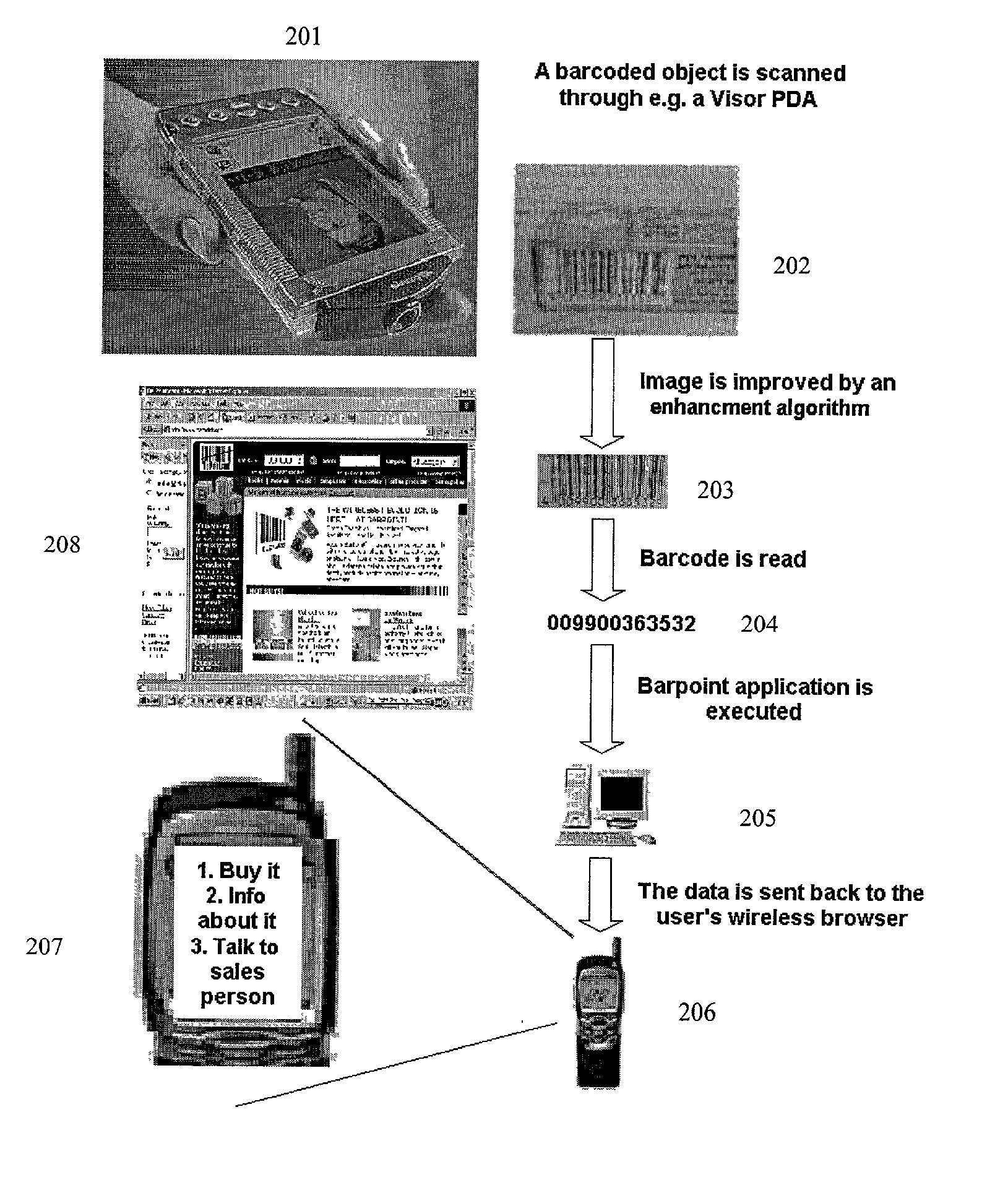2. Portable devices equipped with an imaging device and computational engine for performing OCR,
barcode or
watermark analysis on the scanned / acquired images. The main problem with conventional devices for
image based object identification is that for high quality identification powerful software is required. This software utilizes high-end processors and large quantities of memory, and hence typically runs on a non-portable device such as a
personal computer. As an example for such a
system is the
watermark identification system called MediaBridge.TM. developed by Digimarc Inc, where the
processing is done on a PC.
1. Standard barcodes, sampled by a bar-code reader, featuring a dedicated illuminator and / or
detector optimized for the task of linear bar-code decoding. Pertinent examples include the
barcode readers made by ConnectThings, DigitalConvergence,
Gamut-interactive etc. These devices cannot decode anything by a standard barcode.
2. For performing reliable OCR using limited performance software, one may incorporate into the
system a high quality, special purpose linear
scanner such as the one used in the Quicktionary.TM. product by WizCom. With a special purpose
scanner the OCR task becomes simpler.
3. One can limit the OCR functionality to a very limited set of alpha-numeric characters in a limited set of fonts. Hence the processing and memory requirements are reduced, making the implementation portable. The Quicktionary.TM. and Cpen.TM. devices are examples.
Another problem with conventional devices for
image based object identification is that the portable devices perform
lower grade recognition (such as OCR) because of power, size and price constraints, and hence give the user a
limited capacity in terms of handling difficult imaging conditions, low grade print or
handwriting, special fonts and different languages.
Portable devices are also harder to
upgrade when new versions of software become available.
Another problem with conventional devices for
image based object identification is that the portable devices are special purpose and hence have to be purchased and carried separately to provide only this function.
Furthermore, many of these devices are not connected on-line to
the Internet or other on-line data bases, and hence cannot provide real-time or semi-real-time connection to data based on the scanned image, text or symbols.
While these devices may be suitable for the particular purpose to which they address, they are not as suitable for a user equipped with a portable wireless imaging device to be able to obtain information and services related to imaged objects, where the object identification is performed at least partially by a remote computational facility, and where the object identification is based on acquired images of the object.
1. In the field of algorithms and
image processing operations for removing the effects of imaging under uncontrolled illumination and with low quality / limited imaging devices, there are numerous patents, see e.g. U.S. Pat. No. 5,771,312, incorporated herein by reference. The implementation of such existing algorithms and methods in the remote
server for improving the
image quality for human observers are also not new. The concept of developing and optimizing such algorithms as part of a remote
server for improving the accuracy of the object identification is new.
2. Many algorithms exist for performing printed and hand-typed
character recognition based on images, see e.g. U.S. Pat. Nos. 5,359,671, 6,011,879, 4,977,602, 5,542,006, each of these four patents is incorporated herein by reference. In the method according to the invention, one inventive aspect lies in utilizing such algorithms for performing object identification rather than e.g. performing
word identification as part of inputting a printed page into a computer as text.
3. There is also significant prior art on using special marks or codes such as barcodes, watermarks etc for object identification, see e.g. U.S. Pat. Nos. 5,978,733, 5,933,829, each of these two U.S. patents is incorporated by reference. On the other hand, the inventive method uses standard marks such as numerals or text that appeared on the object for human reading, and emulating the human method of object identification. The limitation of using special marks is that access to the full world of objects that were not marked specifically for automated identification is not available. For example, in the case of scanning barcodes, the inventive method does not require a dedicated barcode
scanner but rather it uses a standard imaging device, and it interprets the data contained in the barcode based on both the lines and the digits rather than based solely on the lines.
 Login to View More
Login to View More  Login to View More
Login to View More 


